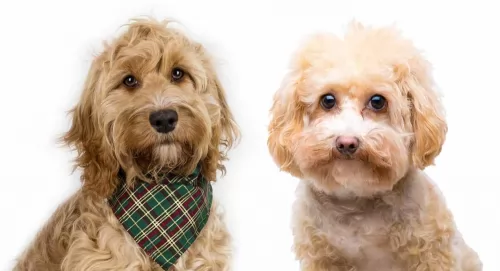 Petzlover
Petzlover Cavapoo is originated from United States but Telomian is originated from Malaysia. Cavapoo may grow 15 cm / 5 inches shorter than Telomian. Both Cavapoo and Telomian are having almost same weight. Both Cavapoo and Telomian has almost same life span. Both Cavapoo and Telomian has almost same litter size. Both Cavapoo and Telomian requires Moderate Maintenance.
Cavapoo is originated from United States but Telomian is originated from Malaysia. Cavapoo may grow 15 cm / 5 inches shorter than Telomian. Both Cavapoo and Telomian are having almost same weight. Both Cavapoo and Telomian has almost same life span. Both Cavapoo and Telomian has almost same litter size. Both Cavapoo and Telomian requires Moderate Maintenance.
 The Cavapoo, known also as the Cavoodle, is a small dog – a mix of a miniature Poodle and a Cavalier King Charles Spaniel.
The Cavapoo, known also as the Cavoodle, is a small dog – a mix of a miniature Poodle and a Cavalier King Charles Spaniel.
He hasn’t got a long history, but each of the dogs he comes from – the Cavalier King Charles Spaniel and the Poodle – have longer histories. The Cavapoo started being bred in the United States, but he has a short history in America. In Australia, they were first bred in the 1990s.
Today, as a hybrid, the Cavapoo isn’t recognized by the American Kennel Club but he is recognized by the American Canine Hybrid Club as well as the Designer Dogs KennelClub.
 The Telomian, out of Malaysia is rare and the only dog bred in Malaysia that lives outside the country. The breed was originally called Village dog or Anjing Kampung in Malay. The Telo is still considered one of the rarest dogs in the world. They are considered as a possible missing link between the Australian Dingo and the African Basenji.
The Telomian, out of Malaysia is rare and the only dog bred in Malaysia that lives outside the country. The breed was originally called Village dog or Anjing Kampung in Malay. The Telo is still considered one of the rarest dogs in the world. They are considered as a possible missing link between the Australian Dingo and the African Basenji.
They were bred to kill vermin by indigenous people, the Orang Asli of Malasia. They have an amazing ability to climb bred into them because these indigenous people lived in stilt houses. Even as they kept the Theomian to hunt vermian, the Orang Asli believed dogs were evil spirits who would eventually turn on them.
In 1963, Dr. Orville Elliot, an anthropologist from the West, discovered the breed and named them the Telomian for the Telom River they lived near. He took a pair to the United States and by 1970 there was a Telomian Dog Club in the U.S. By 1973 another pair had been imported and it is thought that all the Telomians who live in the United States today are descendants of these two pairs.
Like the New Guinea Singing Dog and the Basenji, the Telo do not bark but rather have a unique howl. Being bred from wild dogs, the Telo is not fully domesticate and puppies need a lot of socialization. The Telomian is on the Dog Registry of America Inc and America’s Pet Registry but is not recognized by any pedigree registry.
 The Cavapoo can be found in different colors and he can be blonde, white, brown, white or black or even tri-colored. Sometimes the coat can be a little bit curly but it can also sometimes be a long, silky coat from the Cavalier.
The Cavapoo can be found in different colors and he can be blonde, white, brown, white or black or even tri-colored. Sometimes the coat can be a little bit curly but it can also sometimes be a long, silky coat from the Cavalier.
Dogs crossed with poodles, such as the Cavapoo, are known to be hypoallergenic, but there is really no 100% guarantee that he will be hypoallergenic.He has a round face with large, brown eyes and long ears. He can adapt easily to life in the city or in the countryside.
The Cavapoo is a small dog breed that has been bred to be an amicable pet. He gets along well with adults and children as well as other pets in the home. He stands about 28–33cm in height and can weigh anything from 5 to 12 kg.
He is an intelligent little dog, alert and inquisitive. Even a small, non-aggressive dog such as the Cavapoo can do well with training and socialization as he is quick to learn. With this socialization he becomes an obedient, affectionate, well behaved 4-legged family member.
Loyal and friendly, the Cavapoo thrives on human companionship and he just loves to be involved in everything the family is getting up to. He isn’t a dog that can be left on his own too long as this is when he develops irritating behavior patterns such as ongoing yapping and barking.
 This is a somewhat unique looking breed. They are small dogs, sturdy, athletic dogs with short coat, a square body and a long back. Their coat is smooth and sable and the ticking is white. They often have black masks and purple tongues. They are about 15-18 inches in height and weigh about 18-28 pounds. Their head is well proportioned and they have erect ears, almond shaped eyes and deep chests.
This is a somewhat unique looking breed. They are small dogs, sturdy, athletic dogs with short coat, a square body and a long back. Their coat is smooth and sable and the ticking is white. They often have black masks and purple tongues. They are about 15-18 inches in height and weigh about 18-28 pounds. Their head is well proportioned and they have erect ears, almond shaped eyes and deep chests.
The Telo is still so undomesticated that the female only comes into estrus once a year in September to October. They have great command of their paws and can use them more like cats or racoons. They climb with them and hold toys, objects or food in them. This is related to their need to climb since homes were built on stilts in the jungles of Malaysia.
 Pet lovers who welcome a Cavapoo into their home aren’t going to be disappointed if they stick to their side of the bargain and provide their pet with lots of love and care.
Pet lovers who welcome a Cavapoo into their home aren’t going to be disappointed if they stick to their side of the bargain and provide their pet with lots of love and care.
The Cavapoo suits any kind of family because he is playful, loving, loyal and comes with a balanced and amicable personality.
Keep him happy with good food, clean water and lots of your attention and he’ll respond by being the perfect companion for you.
 2.Special talents – climbing ability, use of their paws, able to hunt their own food.
2.Special talents – climbing ability, use of their paws, able to hunt their own food.
3.Adaptability – they are not big so you would think apartment living would be ok but because of their energy and prey drive they really need a place to run.
 The Cavapoo is considered a healthy little dog who is active and energetic. Because he is a hybrid, he could develop illnesses associated with either of the dog types he comes from. However this is highly unlikely and you can expect up to 15 years from your Cavapoo if you feed him correctly and shower him with lots of love and attention.
The Cavapoo is considered a healthy little dog who is active and energetic. Because he is a hybrid, he could develop illnesses associated with either of the dog types he comes from. However this is highly unlikely and you can expect up to 15 years from your Cavapoo if you feed him correctly and shower him with lots of love and attention.
Dogs with long, floppy ears tend to be more prone to ear infections. You’ll have cause for concern when you see your dog scratching his ears or shaking his head. There are one or two reasons why your Cavapoo may get an ear infection, and food allergies could be one.
A food allergy can bring about inflammation that can lead to infections. Moisture and excessive wax can also cause an ear infection. You can use cotton wool and some ear cleaner to remove dirt and moisture, but if in any doubt, speak to your vet or get your pet to the vet for advice.
Small dogs are more prone to dental disease, and your Cavapoo’s teeth should be brushed 2 or 3 times a week with a vet-approved special dog toothpaste and brush. This can prevent dental decay which can bring about a whole lot of problems with his teeth but also with other parts of the body.
 This is a somewhat unique looking breed. They are small dogs, sturdy, athletic dogs with short coat, a square body and a long back. Their coat is smooth and sable and the ticking is white. They often have black masks and purple tongues. They are about 15-18 inches in height and weigh about 18-28 pounds. Their head is well proportioned and they have erect ears, almond shaped eyes and deep chests.
This is a somewhat unique looking breed. They are small dogs, sturdy, athletic dogs with short coat, a square body and a long back. Their coat is smooth and sable and the ticking is white. They often have black masks and purple tongues. They are about 15-18 inches in height and weigh about 18-28 pounds. Their head is well proportioned and they have erect ears, almond shaped eyes and deep chests.
The Telo is still so undomesticated that the female only comes into estrus once a year in September to October. They have great command of their paws and can use them more like cats or racoons. They climb with them and hold toys, objects or food in them. This is related to their need to climb since homes were built on stilts in the jungles of Malaysia.
 The Cavapoo doesn’t shed much so he won’t need that much grooming, although there are people who take him to a doggy parlor to see that the hair is trimmed into shape. If not, then a good brushing twice a week will ensure the hair doesn’t matt and that it remains free of lots of dead hair.
The Cavapoo doesn’t shed much so he won’t need that much grooming, although there are people who take him to a doggy parlor to see that the hair is trimmed into shape. If not, then a good brushing twice a week will ensure the hair doesn’t matt and that it remains free of lots of dead hair.
With any dog, and not just the Cavapoo, you want a food that boosts energy and promotes longevity. The Cavapoo breed is energetic and lively, and it is this stamina of his that will require you feeding him top quality food that is rich in nutrients.
Small dogs have a higher calorie need than large dogs because their metabolisms are much faster. Protein and fat are important nutrients for small-breed dogs and these nutrients need to come from high-quality sources. Speak to your vet about the best food for your Cavapoo and always ensure that he has a bowl of clean water available.
 This is an isolated, rare breed with very few known genetic health issues. They tend to be very healthy and athletic if well cared for and fed properly. The only issues they are known to have throughout the breed are hip and elbow dysplasia. Both of these issues we know can lead to arthritis and or lameness. Individual dogs may face other challenges such as allergies and obesity, but as a breed they are extremely healthy, much as the dingo and other wild dogs remain healthy.
This is an isolated, rare breed with very few known genetic health issues. They tend to be very healthy and athletic if well cared for and fed properly. The only issues they are known to have throughout the breed are hip and elbow dysplasia. Both of these issues we know can lead to arthritis and or lameness. Individual dogs may face other challenges such as allergies and obesity, but as a breed they are extremely healthy, much as the dingo and other wild dogs remain healthy.
Don’t overfeed them and watch what they might eat or try to eat when outside. They are used to feeding themselves in the wild and the domesticated dogs retain that prey drive and desire to eat what they catch.